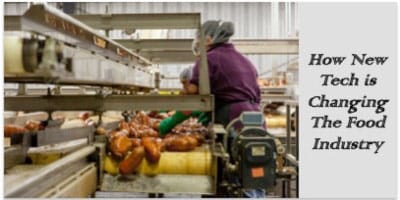How New Tech Is Changing The Food Industry (Guest Blog)

Over the last few decades, advancements in technology have spread across industries. Irrespective of the industry in question, the primary objective of technological advancements remains the same: increasing efficiency. The food industry, like others, has benefited significantly from new tech.
Tech has influenced every part of the food industry, from manufacturing to distribution. Every day, new applications are created to meet the ever-rising demand for food across the globe. The most popular applications of tech in the food industry are related to data processing and robotics engineering. These are some tech trends in the food industry that you should know about.
Robotics in the Food Industry
Thanks to robotics engineering, food manufacturing companies save money and time, increase productivity, and enhance quality. Jobs that a human would take hours to do can be completed within a few minutes by a robot. These robots are indeed displacing human workers but studies have shown that using robots during different parts of the manufacturing process is worth it.
Since the beginning of the Covid-19 pandemic, the application of robotics in the food industry has moved to a whole new level. UVD Robots and many other robotics companies have created robots for food processing and doorstep delivery. Your pizza can be delivered by a robot instead of your regular delivery person. This reduces the chances of spreading Covid while ensuring that clients get their orders. Restaurants have also started hiring robot waiters thanks to the work of hardware and software engineers across the globe.
Mobile Apps in the Food Industry
Mobile app developers are in high demand across industries and the food industry isn’t an exception. There are hundreds of apps for ordering food online, as well as apps for checking the nutritional value of each meal and apps that help you find the best restaurants.
Mobile and web apps aren’t just being used for food delivery services. They are also being used to reduce food wastage. A typical example of such an app is Copia. This app allows businesses with too much food to find nearby shelters. Instead of throwing away all that food, they deliver it to the needy. It doesn’t just have a list of shelters. It also has a list of non-profit organizations, school programs, or any other organization that might need it. Software engineers are doing an amazing job in this regard.
3D Printing in the Food Industry
Right now, 3D printing is one of the many technologies that are changing the world. It is the process of producing food using additive processing techniques. Rather than growing the food on a farm, a syringe is used to deposit a food-grade nozzle in different layers. The latest 3D printers in the market can be controlled remotely with a computer. It allows people to get food in otherwise difficult situations. It is currently being used during space exploration and in the healthcare industry. Many foods that would have been impossible to create in the past are now being produced with 3D printers.
Drones in the Food Industry
Drones have been making waves in the photography, real estate, military, and food industry. Of particular interest is the use of drones in precision agriculture. These drones are used to monitor large farms and prospective farmlands. They come with satellite imagery and GPS systems. These systems allow large scale food producers to increase productivity by sourcing for the best soil and weather conditions. Apart from making the production process more efficient, the analysis from drones can ensure that crops remain healthy until harvesting. It makes mass production quicker and easier than before. Keep in mind that the use of drones doesn’t eliminate the need for farmers. It only makes their job more efficient.
Conclusion
Technological innovation in the food industry has come a long way over the last few years. The pace of this progress is only going to increase as time passes. According to the 2018 census, there are more than 7.5 billion people in the world. While a significant percentage of this number eat three meals a day, millions are hungry. Some children in Sub-Saharan Africa don’t get up to a single meal daily. Technological advancements might be the only viable solution to world hunger in the years to come.
Our guest blog is by Career Karma who help over 1 million workers navigate their careers every month through advice and coaching.






